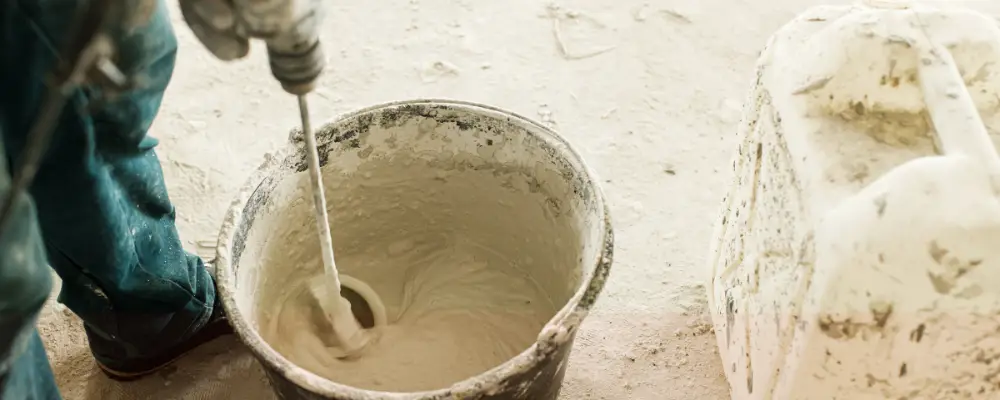Mortar is a mixture of fine aggregates, that is made into a paste, which binds the building blocks together and seals the irregular shapes in the structure. Mortars are ideal in the masonry process and there are numerous mortars in the market. Among them, one of the most ancient mortars that are widely used in modern constructions is the gypsum mortar. Here we take a look at what is a gypsum mortar and everything you need to know about it.
What is Gypsum Mortar?
Gypsum mortar also known as plaster of Paris is a construction material that has been in use since ancient times. It is one of the eco-friendly and economical materials that is applied as a replacement for cement mortar. It is made with gypsum as the primary material that is mixed with sand, and water at an appropriate ratio. After the water gets evaporated, the plastic mixture becomes hard.
Composition of Gypsum Mortar
Gypsum
It is the primary raw material that is finely ground and calcinated to remove the moisture content, to make it a white powder known as plaster of Paris. Gypsum powder, when mixed with water, rehydrates to form a hard and solid substance.
Sand
Sand is the secondary raw material used, which increases the volume and workability of the mortar. The sand used in the mortar should be fine and free from impurities and stones to provide a smooth finish when applied to the surface.
Water
Water plays a vital role in transforming the gypsum and sand mixture into a workable paste. Water rehydrates the gypsum and brings it to a plastic consistency to get applied on walls, ceilings, and other surfaces of the building.
Application of Gypsum Mortar
Gypsum Mortar is one of the most versatile construction materials, known for its workable properties. Here are some of the key applications.
Plastering
Gypsum Mortar is a popular choice for plastering walls and ceilings to achieve a smoother and even surface finish before painting or adding stickers. Its quick setting time allows the construction process to proceed at a faster pace.
Skimming
Gypsum Mortar has a fine texture and excellent adhesive properties, making it an ideal material for skimming on plastered surfaces.
Molds & Ornaments
This mortar has the ability to capture fine details, for which it is used to create molds, cornices, and other ornamental parts of the building.
Repair
The rapid hardening process of gypsum mortars makes it an ideal element for patching cracks and holes in the buildings. They provide effortless repairs, that easily blend with the existing material.
Fixing Tiles
This mortar is used as an adhesive to fix tiles on the floor and walls due to its quick setting time and smooth application.
Advantages & Disadvantages of Gypsum Mortar
Advantages
- Gypsum mortar is known for its faster setting time, which helps the construction process to go rapidly.
- This mortar is comparatively smoother than cement or lime mortars, giving it a high-standard finish.
- They are easy to apply and shape, thereby reducing the time and effort of the laborers.
- Gypsum is highly resistant to fire and is an excellent choice to protect the building from any fire attacks.
- The raw materials used, including gypsum, sand, and water, are natural, which reduce the carbon footprint.
- Gypsum can be recycled and is an environmentally friendly option.
- It possesses good sound insulation properties due to the tiny voids in the mortar.
Disadvantages
- Gypsum mortar cannot be used for external structures or water-prone areas, as it has poor water resistance.
- The cost of gypsum is higher compared to other mortars.
- Gypsum cannot be stored for a long period of time after manufacturing.
How to apply Gypsum Mortar?
Mixing
An adequate proportion of gypsum powder (plaster of Paris) and sand should be mixed with clean water in a container to avoid contamination. The mixing process should continue until the mixture becomes lump-free and attains a plastic consistency. It is important to note that the amount of mix prepared should be used within 30 minutes due to its quick setting time.
Applying
After blending into a paste, the mortar is applied in thin layers using a trowel or a plastering tool. If the gypsum paste is used for plastering, the thickness should be 1-2 mm. Ensure that the surface is clean and slightly damp to improve the adhesion.
Curing
This mortar has a rapid setting time and does not require any curing like a cement mortar. However, the mortar should be protected against high temperatures using damp cloths or plastic sheets.
Temperature Considerations
These mortars should be applied at temperatures above 5°C (41°F) and below 35°C (95°F) for proper setting and enhanced performance.
Conclusion
Gypsum Mortar is one of the most versatile construction materials widely used in the modern construction industry. It provides a wide range of applications for interior structures, offering a high-standard appearance in a short period. Their excellent properties and advantages make them an ideal choice. Although it offers numerous advantages, its cost, availability, short lifespan, and inability to withstand moisture hit back. This mortar could be a great fit for internal structures and projects where high-quality results are crucial.

